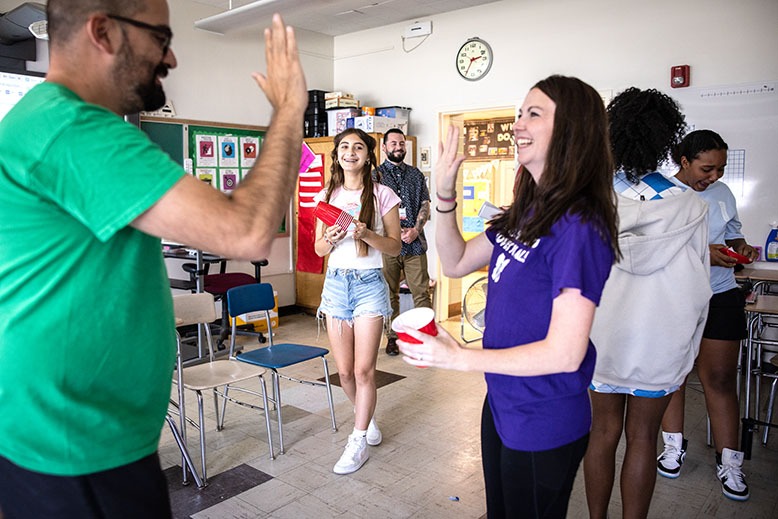
More than two years into the pandemic, school life as we knew it has transformed. Students, educators and parents are still experiencing challenges. Many districts have embraced innovations in learning and mental health to help.
Here, we explore what our schools are facing.
MORE FROM THIS ISSUE:
These Unique Programs and Courses Engage NJ Students of All Ages
NJ’s Acting Education Commissioner Talks Teacher Shortages, Safety and Mental Health
Small Colleges Are Struggling. Will They Survive?
Meet Teik Lim, NJIT’s First President of Color
Saint Peter’s Still Reaping Rewards of Miraculous NCAA Tournament Run
The student was depressed and wanted to end it all. But in the throes of that darkness, the teen turned to a classmate who urged the student to seek help. Together, they approached a staff member at the Greater Egg Harbor Regional High School District, located in Atlantic County. The employee, working with the district’s mental health specialists, helped the teen get treatment. “Just this year, we’ve had a few students reporting thoughts about self-harm,” says James M. Reina, superintendent of the district, which includes three high schools. “This student had a plan, and had the means, and a reason they were going to take this tragic step. Their peer said, ‘You’ve got to share this.’ We helped the kid get access to an inpatient facility.”
It’s all part of a support system that will greet students in the new school year. It revolves around raising awareness among students and staff about mental health, and providing guidance and resources to those who need them. Students and teachers will be trained to reach out to others who are struggling. By recognizing that mental health is as important as physical health, it will be destigmatized.
“It is part of our training for our staff, and it’s embedded in our curriculum,” Reina says of the focus on mental wellness, which the district began incorporating several years ago and bolstered during the pandemic.
In the 2022-2023 academic year, school districts across New Jersey say they will integrate mental health into everything from the curriculum to activities to cafeteria seating, as the number of children—from pre-kindergarten through high school—struggling with anxiety, depression and suicidal thoughts has grown from worrisome before the pandemic to what federal officials have now declared a national emergency.

Buy our September 2022 issue here. Cover photo by Benjamin Norman
While learning loss during the pandemic prompted some districts to hire tutors, offer extra hours of classroom instruction to at-risk kids, and take other steps to help students, the social impact of lockdowns and the disorientation it created has pushed mental wellness to the fore in teaching and extracurricular activities, school officials say.
Many districts have implemented state and national initiatives, like Handle With Care, in which law-enforcement officers who respond to a potentially traumatizing situation for a child will alert the school without divulging details about the incident. The idea is that with that knowledge, school staff can then handle the student more mindfully, watching for signs of trauma, providing emotional support, and allowing them more time to complete class work. This school year, numerous districts will employ Social Emotional Learning, which teaches empathy, self-awareness, managing emotions and relationship skills, among other things.
The Bloomfield School District has embraced mental wellness as a priority since before the pandemic, when it incorporated Start With Hello, a program created by Sandy Hook Promise, a nonprofit organization founded by families of children who were killed at the Sandy Hook Elementary School in Connecticut in 2012. Through activities and classroom lessons, the program aims to eliminate social isolation by teaching children to include others and lift spirits through simple acts of kindness. In the 2022-2023 school year, parent and student volunteers will post signs with positive messages such as, “You are strong,” “You are beautiful,” and “You can do it.” On other occasions, students will leave anonymous “kindness notes,” complimenting or encouraging a classmate.
“You can make someone’s day just by saying hello to someone,” says Joseph Fleres, the assistant superintendent.
The district also enhanced its social-emotional learning agenda by adding the Wingman program, which trains students to be leaders in creating an empathetic and inclusive environment. The program was created by another Sandy Hook parent, Ian Hockley, whose 6-year-old son died in the massacre. Hockley says he liked the concept of the wingman, a term in the Air Force for someone who has another’s back.

In Bloomfield, Wingman program participants help peers develop empathy and inclusivity. Photo by Benjamin Norman
Gina Rosamilla, the principal of the Watsessing Elementary School in Bloomfield, says that at-home learning during the pandemic was particularly trying for her students. “Our socioeconomic status is lower,” Rosamilla says. “Some kids were sitting at the kitchen table [doing schoolwork], and they had to take care of their younger siblings. Some lost family members [to Covid-19], and they were trying to learn as they were dealing with loss. They were trying to learn as their relatives worried about keeping their jobs.”
With Covid surges and outbreaks not yet things of the past, Bloomfield schools, like others across the state, are prepared to continue mental wellness remotely, they say. Earlier in the pandemic, Mike Bruno, the district supervisor of guidance, pushed for programs like Wingman to continue even as schools were forced to shift to remote learning. If ever the kids needed an emotional boost, he told district officials, it was then.
“We had student leaders join students in lower grade levels for sharing circles on Google Meet to have a true sense of inclusivity,” says Laura Foster, a teacher at Watsessing and a Wingman program coordinator.
Wingman student leaders in the upper middle school grades work with younger students on social and emotional learning, even succeeding in motivating some who are introverted to become Wingmen.
The program is so popular that enrollment in the middle school for the coming school year has nearly doubled to more than 80 from 44.“It’s the most, by far, we’ve had sign up,” says Greg Murray, a computer science teacher involved with the Wingman program at Bloomfield Middle School.
“There was one student who didn’t want to participate,” says Wingman and ninth-grader Sophia Sorge. “She didn’t want to speak to anyone she didn’t know. So any time we went to her classroom, we’d pair her with a Wingman so she could share her ideas on the activities we were doing. Each time, she got a bit more comfortable.”

Staff member Gregory Murray, left, works with two students at Bloomfield Middle School. Photo by Benjamin Norman
One boy was often teased because of speech issues, Foster says. He was usually alone on the playground while other kids socialized with friends. A teacher encouraged him to be a Wingman leader.
“He really took on the role,” Foster says. “It shifted the dynamic from him being a loner to being a leader, and when he saw someone sitting by himself, he went up to them and got them to play a game.” The boy, who is now thriving socially and academically, credited the program with changing his life.
“He was able to reach other students who were the loner or the quirky one, who he identified with, and he brought them out of their shell and comfort zone,” Foster says.
Tabitha Rice, librarian and media specialist at Bloomfield Middle School, says the library’s lunchtime activities can be a haven for students who don’t want to spend the period in the cafeteria. “We tend to get loners and kids who need community,” she explains. “We do projects such as arts and crafts, we have a Lego wall, we’ve melted down Jolly Ranchers and made roses with them, and we do STEM [activities]. It’s so every kid has a safe place that’s comfortable for them.”
In September, the Maurice River Township School District staff will be trained in suicide prevention and how to identify and handle trauma in children. “Coming out of this pandemic, we saw that the mental health needs of the kids were exacerbated,” says Jeremy Cohen, the chief school administrator of the district. “These kids have lost so many social skills over the pandemic. We’re seeing the mental health needs in [even] younger kids. I have pre-K and kindergarten kids who have some severe mental health needs. Parents don’t know where to go for help, so right now, they’re turning to the schools.”
***
The district formed a partnership last year with Rowan College, which has a Social Emotional Learning program that trains staff and provides counseling to students on a monthly basis. For the first time, all district teachers became certified in Youth Mental Health First Aid, and four employees received their certification in the Nurtured Heart Approach, which stresses building children’s self-esteem. The district is also one of hundreds across the country that works with Care Solace, a California-based company launched in 2020 that connects schools and families with local and online mental health resources.
“Having these programs run parallel to one another has been phenomenal,” Cohen says. “In Cumberland County, there aren’t many community-based mental health programs.”
Like other school administrators, Cohen says the pandemic emotionally drained teachers and other staff members. “It wasn’t just the kids. The mental health needs of the staff were magnified by 1,000—they hadn’t been around the kids,” he says. “The needs of these kids and the staff have still been rising. We won’t see the full toll for another year or two.”
The U.S. Department of Health and Human Services reported that pre-pandemic, one in five children ages 3–7 had a mental, emotional, developmental or behavioral disorder. And yet, the American Academy of Pediatrics said in a 2019 report, few got the services they critically needed for their disorders—which, it noted, “could jeopardize their health long into adulthood”—because of barriers such as stigma, a shortage of mental health providers, and affordability.
High school students who revealed feeling hopelessness soared by 40 percent between 2009 and 2019, with 19 percent considering suicide and 16 percent having made a plan to carry it out. In 2020, more than 6,600 people ages 10–24 died by suicide.
In December, U.S. Surgeon General Dr. Vivek Murthy sounded the alarm, issuing an advisory on the mental health crisis among youth. Murthy said the pandemic had intensified existing problems among youth of isolation, financial hardship, bullying and anxiety.
His warning followed a move in October by three groups—the American Academy of Pediatrics, the American Academy of Child and Adolescent Psychiatry, and the Children’s Hospital Association—to declare a national state of emergency in children’s mental health. The declaration emphasized the important ability of schools to detect and monitor signs of mental illness and provide resources that can improve mental health. The coalition recommended, among other things, increased implementation and funding for school-based mental health care and boosting suicide-prevention programs in schools and other settings.
***
A report in June by the New Jersey Hospital Association revealed that mental illness in youth is driving an increase in inpatient admissions. NJHA said depression was the leading diagnosis among youth ages 12–17. Between 2019 and 2021, the organization noted that hospitalization due to self-harm jumped 95 percent, and admissions due to anxiety rose 54 percent.
“We are witnessing the extended impact of the pandemic on the demand for mental health services,” says Cathy Bennett, NJHA president and CEO. “The emergency department is very often the first point of contact for youths in mental health crisis, but now we see that journey continuing into inpatient care in our hospitals.”
A Centers for Disease Control and Prevention report in April reported that young people who felt close to people at school—whether in-person or virtually—experienced better mental health than those who did not. Making students comfortable about confiding in someone at school, be it a classmate, a teacher or another staff member, has become a pillar of mental wellness at the Greater Egg Harbor Regional High School District, says Reina.
The area has seen suicide attempts by high school and middle school students over the years. According to Reina, the district was stunned by the suicide a few years ago of a senior two weeks before his graduation. He’d been in the top three of his class and seemed to have everything going for him. “He broke all the stereotypes of what that crisis looks like,” says Brenda Callaghan, the district supervisor of special projects.
The tragedy strengthened the district’s “resolve to reach every kid,” says Reina. “Nothing is more important than the fact that every student has two or three adults they’re comfortable going to,” he says, adding that it could be about their own struggles or concerns they have about a fellow student. “If you do have a student thinking about doing harm to themselves or others, kids will say, ‘I have to go tell Mrs. Smith.’ They know our teachers are trained,” he says.
Ninth-graders attend suicide-prevention seminars, and tenth-graders are trained to provide peer support. “They ask questions, they persuade their peer to seek help and also to tell that trusted adult,” Reina says.
In an effort to destigmatize mental illness, Reina has spoken to students about his issues. “I’ve stood in front of people and talked about my struggle with anxiety over the years,” he says. “If we can get students, when they’re teenagers, to see the value of being open with mental health, just as we are with physical health, maybe it will happen globally.”
Callaghan agrees being proactive is critical for mental health. She said the district has done that by making mental wellness part of the curriculum, incorporating social-emotional learning tools to help students communicate and make wise decisions. The district has broadened the use of therapy dogs in the schools, which were present sporadically but can now be brought in by any teacher. A librarian often brings in a therapy dog, and twice a week, a science-class teacher walks one through the building twice a day.
But often, those programs are not enough, Callaghan admits, and mental health professionals must step in to provide the level of expertise only they possess in given situations.
For instance, the district has long partnered with AtlantiCare Behavioral Health, which operates a teen center at Oakcrest High School and several other schools in South Jersey.
“We have AtlantiCare in each of our buildings,” Callaghan says. “Intervention can keep something from turning [into a crisis].
“One of the challenges is, often you have programs, you can embed them in the curriculum, but sometimes you need an extra layer.”
The Paterson school district, serving one of the poorest populations in New Jersey, has received $9.5 million in federal relief funding to hire five additional behavioral analysts and two substance abuse coordinators tasked with identifying and helping at-risk students, according to an Associated Press report.
The Maurice River Township School District is stepping up the mental health resources available to students. In the new school year, it is bringing in a full-time child-study team, says Cohen. The team will include a school psychologist, a social worker, a registered behavior technician and a consultant for the learning disabled, among others.
“We’re going to have our own people, in-house, five days a week, eight hours a day,” Cohen says. “We’re going to be able to really focus on the mental health needs of our students.”
Many school districts have adapted their teaching models—often with government pandemic-relief funds—to address the disruptions in learning that occurred during lockdown.
Bloomfield, for example, formed Backstop, a program that provides additional in-class instruction time during the school year and summer to K-6 students deemed to have fallen behind during remote learning. It is funded through 2024.
“As good as our virtual learning was,” says Reina, “it can never replace classroom learning. We’re focusing mainly on the areas of math and language arts—unfortunately those two suffered during the pandemic.”
Maurice River has expanded its Esports program, which redirected students who spent more time on their computers during lockdown into an activity that put everyone on a level playing field with athletic youths.
“We took kids who weren’t really social or who struggled through the pandemic, and we formed Esports teams,” Cohen says. “They’re playing competitive games like soccer on the computer. It’s not just about playing games. This program was bringing kids who are severely autistic and can’t play sports with football stars, and now they’re playing together. These types of programs focus on the social-emotional learning needs of our students.”
Elizabeth Llorente’s work has appeared in Forbes, the New York Times and AARP.
